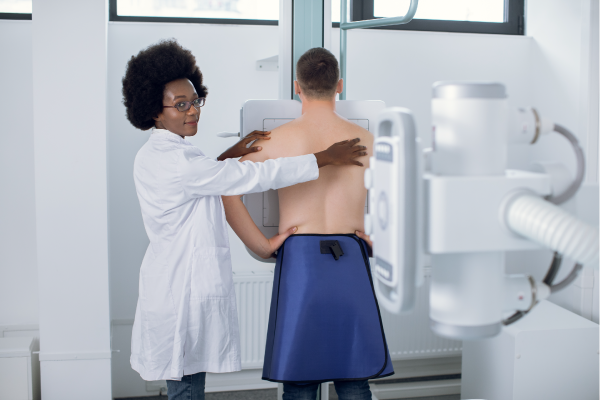How much are radiographers paid in 2022?

A radiographer or radiologic technologist is a vital healthcare team member who uses imaging technology to create diagnostic images of the human body. As an essential part of the diagnostic process, radiographers play a critical role in patient care. But how much are radiographers paid?
This guide provides an overview of what you can expect to earn as a radiographer. It will also offer tips on how to maximise your earnings as a radiographer.
What is a radiographer?
Radiographers operate special scanning machines that create human body images. Physicians use these images to diagnose and treat diseases.
They may use several different tools and procedures to help them in their work. For example, they may use X-ray machines, ultrasounds, magnetic resonance imaging (MRI) and other imaging equipment to take pictures of the inside of the body. They may also use specialised software to process and analyse these images.
Radiologic technologists must be highly trained in the use of these machines and must follow strict safety protocols to protect themselves and their patients from harmful radiation.
Types of radiography careers
There are many different types of radiography careers. Here are some of the most common:
Diagnostic radiographer: These professionals use X-rays and other imaging technologies to produce diagnostic images of patients' bodies.
Interventional radiographer: These technologists work in image-guided procedures, such as angiography, biopsies, and cancer treatments.
Radiation therapist: Radiation therapists use radiation to treat cancer patients.
Radiology nurse: Radiology nurses care for patients undergoing diagnostic or interventional procedures.
Nuclear medicine technologist: Nuclear medicine technologists use radioactive materials to help diagnose and treat medical conditions.
Ultrasound technologist: Ultrasound technologists use sound waves to create images of patients' bodies.
Education and training
Radiographers typically have a degree in diagnostic radiography from an accredited institution. After graduation, they must complete a clinical placement in order to gain hands-on experience. Many radiographers pursue additional training and education to specialise in a particular area of radiography, such as computed tomography (CT) or magnetic resonance imaging (MRI).
How much are radiographers paid?
One of the most asked questions is "How much are radiographers paid"? According to Payscale Payscale, the average salary for a radiographer in the UK is £28,741 per year. They typically earn a base salary of £23,000 to £41,000 per year – with a bonus of £504 to £25,000 per year. However, salaries will vary depending on experience, location, and employer.
Most radiographers work within the National Health Service (NHS), and their salaries start at band 5. Radiographers in the lower bands typically have less experience and responsibility than those in the higher bands.
According to the latest figures, the salary for a band 5 NHS worker is between £27,055 and £32,934 per year.
For a band 6 radiographer, the salary is between £33,706 and £40,588 per year while the salary for a Band 7 NHS worker is between £41,659 and £47,637 per year.
The salary for a band 8 healthcare professional is between £49,946 and £91,787 per year. This is a very competitive salary and reflects the high level of skills and experience that these workers possess.
Finally, the salary for a band 9 employee is between £95,135 and £109,475 per year. This is a significant salary range, and workers in this band typically have a great deal of experience and responsibility.
How to increase your earnings as a radiographer?
If you're looking to grow your earnings as a radiographer, there are a few things you can do:
Get experience
The more experience you have, the more you can charge for your services. There are a few ways to get experience: you can work in a hospital, in private practice, or in a research setting. Each of these settings will have different pay scales, so you'll need to research what each one offers. Once you have experience, you can start negotiating your salary and benefits. Remember, the more experience you have, the more you're worth!
Staying up-to-date on the latest technology
As new technology emerges, employers will be willing to pay more for someone trained in using it. Therefore, stay up to date on the latest advances to maximise your earnings.
Specialise in a specific area
You can choose from many different specialities. So do some research and find one that interests you. Once you have chosen a speciality, you can start marketing yourself as an expert in that field. This will help you attract higher-paying clients and jobs.
Apply for locum radiography jobs
One of the best things you can do to increase your earnings as a radiographer is to apply for locum radiography jobs. By working as a locum, you can often command higher rates than if you were a permanent staff member.
Locum radiographers have the potential to earn more than £40 per hour.
There are a few avenues that you can take to get a locum radiography job. The most common way is to search online job boards or databases specialising in health care jobs. You can also contact a radiography locum agency that places radiographers in temporary positions. These agencies will often have jobs which might not be accessible on standard job boards.
Also, you can reach out to hospitals or radiology practices directly to inquire about open positions. Whichever route you take, be sure to emphasise your experience and qualifications in your communications.
Frequently Asked Questions (FAQs)
What are the job prospects for radiographers?
There is currently a high demand for radiographers in the United Kingdom, and the career outlook for this profession is very positive. The employment of radiographers is expected to grow about as fast as the average for all occupations over the next decade. There are also many opportunities to work abroad.
What is a typical day like for a radiographer?
Radiographers typically work in hospitals or clinics, and their day-to-day duties may vary depending on their speciality. However, most radiographers spend their days performing diagnostic imaging examinations, such as X-rays, on patients.
What is the difference between radiographers and radiologists?
Radiographers use X-rays, computed tomography (CT) scans, magnetic resonance imaging (MRI) scans and other equipment to create body images. Radiologists are physicians who interpret these images to diagnose diseases and injuries.
How do I become a radiographer in the UK?
If you're a qualified radiographer who's looking to move to the UK for their radiography career, or if you're considering radiography as a career choice, we have outlined how to become a radiographer in the UK here.
If you're looking for a healthcare job in the UK, Globe is the perfect recruitment agency for you. We have clinician-led teams who know the national healthcare market inside out, and we can also connect you with roles in New Zealand and Australia.
So why wait? Take a look today and start your job search!

Latest Radiography Jobs
We currently have a variety of locum and permanent vacancies across the UK and Ireland





